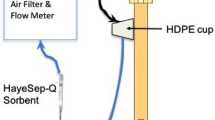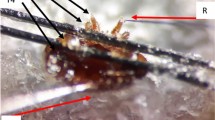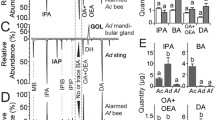Abstract
The Afro-tropical scarab Oplostomus haroldi (Witte) is a pest of honeybees in East Africa with little information available on its chemical ecology. Recently, we identified a female-produced contact sex pheromone, (Z)-9-pentacosene, from the cuticular lipids that attracted males. Here, we investigated the kairomonal basis of host location in O. haroldi. We used coupled gas chromatography/electroantennographic detection (GC/EAD) and GC/mass spectrometry to identify antennally-active compounds from volatiles collected from honeybee colonies. Antennae of both sexes of the beetle consistently detected seven components, which were identified as 3-hydroxy-2-butanone, 2,3-butanediol, butyl acetate, isopentyl acetate, butyl butyrate, hexyl acetate, and methyl benzoate. In olfactometer bioassays, both sexes responded to the full seven-component synthetic blend over solvent controls, but chose honeybee colony odors over the blend. These findings suggest that the seven compounds are components of a kairomone from honeybee colonies used by O. haroldi.




Similar content being viewed by others

References
Benda N, Boucias D, Torto B, Teal PEA (2008) Detection and characterisation of Kodamaea ohmeri associated with small hive beetle Aethina tumida infesting honey bee hives. J Apic Res 47:193–200
Bengtsson JM, Wolde-Hawariat Y, Khbaish H, Negash M, Jembere B, Seyoum E, BS H, MC L, Hillbur Y (2009) Field attractants for Pachnoda interrupta selected by means of GC-EAD and single sensillum screening. J Chem Ecol 35:1063–1076
Bengtsson JM, Khbaish H, Reineckle A, Wolde-Hawariat Y, Negash M, Seyoum HBS, Hillbur Y, Larsson MC (2011) Conserved, highly specialized olfactory neurons for food compounds in 2 congeneric scarab beetles, Pachnoda interrupta and Pachnoda marginata. Chem Senses 36:499–513
Donaldson JMI (1989) Oplostomus fuligineus (Coleoptera: Scarabaeidae): life cycle and biology under laboratory conditions, and its occurrence in bee hives. Coleopt Bull 43:177–182
Dukas R (2008) Evolutionary biology of insect learning. Annu Rev Entomol 53:145–160
Fombong AT, Haas F, Ndegwa PN, Irungu LW (2012a) Life history of Oplostomus haroldi (Coleoptera: Scarabaeidae) under laboratory conditions and a description of its third instar larva. Int J Trop Insect Sci 32:56–63
Fombong AT, Teal PEA, Arbogast RT, Ndegwa PN, Irungu LW, Torto B (2012b) Chemical communication in the honey bee scarab pest Oplostomus haroldi: role of (Z)-9-pentacosene. J Chem Ecol 38:1463–1473
Fombong AT, Mumoki F, Muli E, Masiga D, Arbogast RT, Teal PEA, Torto B (2013) Occurrence, diversity and pattern of damage of two Oplostomus species (Coleoptera:Scarabaeidae), honey bee pests in Kenya. Apidologie 44:11–20
Food and Agriculture Organization of the United Nations (FAO) (2006) Honey bee diseases and pests: A practical guide. Rome, Italy
Hepburn HR, Radloff SE (1998) Honey bees of Africa. Springer, Berlin, Germany
Hölldobler B, Wilson EO (1990) The ants. Springer, Berlin, Germany
Johannsmeier MF (2001) Beekeeping in South Africa. Plant protection research institute, Pretoria, South Africa
Knudsen J, Ollsten L, Bergstrom G (1993) Floral scents-a check list of volatile compounds isolated by head-space techniques. Phytochemistry 33:253–280
Knudsen J, Eriksson R, Gershenzon J, Ståhl B (2006) Diversity and distribution of floral scent. Bot Rev 72:1–120
Moritz FA, Hillesheim E (1990) Olfactory discrimination between group odours in honey bees: Kin or nestmate recognition? Insect Soc 37:90–99
Nazzi F, Le Conte Y (2016) Ecology of Varroa destructor, the major ectoparasite of the western honey bee Apis mellifera. Annu Rev Entomol 61:417–432
Njau MA, Mpuya PM, Mturi FA (2009) Apiculture potential in protected areas: The case study of Udzungwa Mountains National Park, Tanzania. IJBESM 5:95–101
Nojima S, Sakata T, Yoshimura K, Robbins PS, Morris BD, Roelofs WL (2003) Male specific EAD active compounds produced by female European chafer Rhzotrogus majalis (Razoumowsky. J Chem Ecol 29:503–507
Oyerinde AA, Ande AT (2009) Distribution and impact of honey bee pests on colony development in Kwara State, Nigeria. JASS 5:85–88
Rochat D, Morin J-P, Kakul T, Beaudoin-Olliveir L, Porior R, Renou M, Isabelle M, Stathers T, Embupa S, Laup S (2002) Activity of male pheromone of Melanesian rhinoceros beetle Scapanes australis. J Chem Ecol 28:479–499
Smyth RR, Tallamy DW, Renwick JAA, Hoffmann MP (2002) Effect of age sex and dietary history on response to curcubitacin in Acalymma vittatum. Entomol Exp Appl 104:69–78
Steenhuisen S-L, Jürgens A, Johnson SD (2013) Effects of volatile compounds emitted by Protea species (Proteaceae) on antennal electophysiological responses and attraction of Cetoniine beetles. J Chem Ecol 39:438–446
Stensmyr MC, Larsson MC, Bice S, Hansson BS (2001) Detection of fruit- and flower emitted volatiles by olfactory receptor neurons in the polyphagous fruit chafer Pachnoda marginata (Coleoptera: Cetoniinae. J Comp Physiol 187:509–519
Suazo A, Torto B, Teal PEA, Tumlinson JH (2003) Response of the small hive beetle (Aethina tumida) to honey bee (Apis mellifera) and beehive produced volatiles. Apidologie 34:525–533
Tolasch T, Solter S, Toth M, Ruther J, Wittko F (2003) R)-acetoin- female sex pheromone of the summer chafer Amphimallon solstitiale (L. J Chem Ecol 29:1045–1050
Torto B, Suazo A, Alborn H, Tumlinson JH, Teal PEA (2005) Response of the small hive beetle (Aethina tumida) to a blend of chemicals identified from honeybee (Apis mellifera) volatiles. Apidologie 36: 523–532
Torto B, Arbogast RT, Alborn H, Suazo A, van Engelsdorp D, Boucias D, Tumlinson JH, Teal PEA (2007a) Composition of volatiles from fermenting pollen dough and attractiveness to the small hive beetle Aethina tumida, a parasite of the honey bee Apis mellifera. Apidologie 38:380–389
Torto B, Arbogast RT, van Engelsdorp D, Willms S, Purcell D, Boucias D, Tumlinson JH, Teal PEA (2007b) Trapping of Aethina tumida (Coleoptera: Nitidulidae) from Apis mellifera (hymenoptera: Apidae) colonies with an in-hive baited trap. Environ Entomol 36:1018–1024
Torto B, Boucias DG, Arbogast RT, Tumlinson JH, Teal PEA (2007c) Multitrophic interaction facilitates parasite-host relationship between an invasive beetle and the honey bee. Proc Natl Acad Sci U S A 104:8374–8378
Torto B, Fombong A, Mutyambai D, Muli E, Arbogast R, Teal P (2010) Aethina tumida (Coleoptera: Nitidulidae) and Oplostomus haroldi (Coleoptera: Scarabaeidae): Occurrence in Kenya, distribution within honey bee colonies and responses to host odours. Ann Ent Soc 103:389–396
Vuts J, Imrei Z, Birkett MA, Pickett JA, Woodcock CM, Tóth M (2014) Semiochemistry of the Scarabaeoidea. J Chem Ecol 40:190–210
Wakefield M.E. (1998) The effect of insect age on the response of three species of Sitophilus to 4S,5R-sitophilure and food volatiles. Proceedings of the 7th International Working Conference on Stored-Products Protection, 2, 1513–1518.
Wolde-Hawariat Y, Seyoum E, Jembere B, Negash M, Hansson B, Hillbur Y (2007) Behavioural and electrophysiological response of the sorghum chaffer Pachnoda interrupta (Coleoptera: Scarabaeidae) to plant compounds. Int J Trop Insect Sci 27:53–61
Acknowledgments
The authors are grateful to Dr. D. Salifu for statistical advice; R. Herisolo for the olfactometer drawing; J. Kilonzo, J. Ngang’a, and A Mwajeve for field assistance with bee odors, frame, and beetle collections from the apiary. The authors are grateful to two anonymous reviewers for comments on an earlier version of the manuscript. The German Academic Exchange Service (DAAD) funded ATF while project funding came from the United States Department of Agriculture – Agricultural Research Service (USDA-ARS Project No. SCA-586615-7-119F).
Author information
Authors and Affiliations
Corresponding author
Additional information
Peter Teal passed away on 11th February 2015
Rights and permissions
About this article
Cite this article
Fombong, A.T., Mutunga, J.M., Teal, P.E.A. et al. Behavioral Evidence for Olfactory-Based Location of Honeybee Colonies by the Scarab Oplostomus haroldi . J Chem Ecol 42, 1063–1069 (2016). https://doi.org/10.1007/s10886-016-0748-1
Received:
Revised:
Accepted:
Published:
Issue Date:
DOI: https://doi.org/10.1007/s10886-016-0748-1



